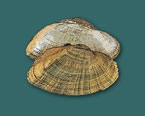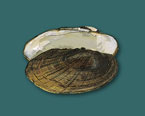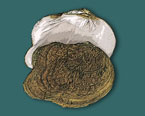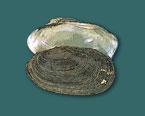
Gone Fishin’
One of the most amazing things
about freshwater mussels is the use of host fish as a part of their lifecycle.
To get their glochidia into a fish’s gills, they have to lure them in
close. The inevitable analogies regarding human fishermen quickly surface.
When mussels go fishing, it’s a challenge any angler quickly understands.
Check out these amazing adaptation.
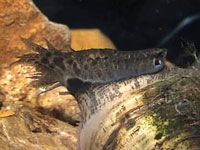 |
 MINNOW
LURE MINNOW
LURE
The pocketbook mussel depends on bass for its host. Females have special
flaps on its mantle that resemble a small fish. The mussel extends
the flaps from the shell and waves the lure in the water. Bass
cannot resist and try to strike the lure thinking it is a tasty minnow
to eat. Instead, the fish gets a mouthful of pocketbook glochidia. |
 |
 CRAYFISH
LURE CRAYFISH
LURE
The rainbow mussel (Villosa Iris)
uses smallmouth bass for its host. The favorite food
of smallmouth bass is crayfish. So this little mussel
has a crayfish lure that can be walked across the bottom.
|
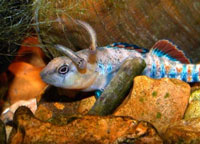 |
 WET
FLY WET
FLY
Fly fishermen use a dainty, sinking lure
called a “wet fly” that resembles a small insect. The
kidneyshells are “fly fishermen” of the mussel world. These
mussels release small packages called conglutinates that resemble
aquatic insects, but are filled with glochidia. When
small fish like darters try to eat them, the conglutinate ruptures,
releasing glochidia into the mouth and gills of the fish. |
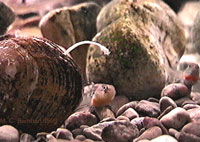 |
 WORMS WORMS
Everyone uses worms for fishing, and mussels
are no different. Fanshells release worm shaped conglutinates
that are probably tasty to fish because they are made of mussel eggs
and glochidia. When the host fish (darters in this case) eats
the worm, some of the glochidia attach to the gills of the fish. |
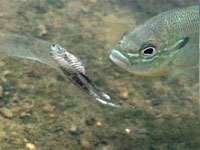 |
 LINE
AND LURE LINE
AND LURE
The Orange nacre mussel perhaps has the
most incredible mussel lure of them all. They release
a conglutinate that looks like a small prey fish, but it is
attached on a long, transparent mucus strand up to one meter
in length. Being attached to the mussel makes the lure
look like a fish swimming against the current. When bass
mistake it for an easy meal, they are infested with the glochidia. |
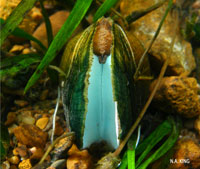 |
GLOW IN THE DARK LURES
These mussels display mantle flaps that are so
iridescent that they almost glow in the dark. These displays
probably are for attracting fish host, but exactly how they interact
with their fish host is a mystery. |
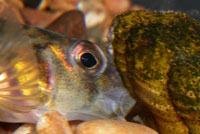 |
CATCH AND RELEASE
Mussels want to conserve good fishing too and
some like these little snuffbox mussels practice catch and release. These
mussels trap their fish host, force glochidia onto their gills, and
then release them to fight another day. |
| |
THE ULTIMATE SACRIFICE
Some mussel mothers make the ultimate sacrifice
to take advantage of some fish that like to eat mussels for dinner. When
it is time, mussels like this federally endangered scaleshell lie
on the top of the substrate and wait. They wait until a hungry
fish swims by to eat them. While the fish chomps down on the
crunchy treat, larvae the female was holding become attached to the
gills. In this case, just any mussel-eating fish will not do. Scaleshell
needs to be eaten by a freshwater drum as that is the only fish that
will support the development of the glochidia. |
Photos and Videos, courtesy of Chris Barnhart's Unio
Gallery.



